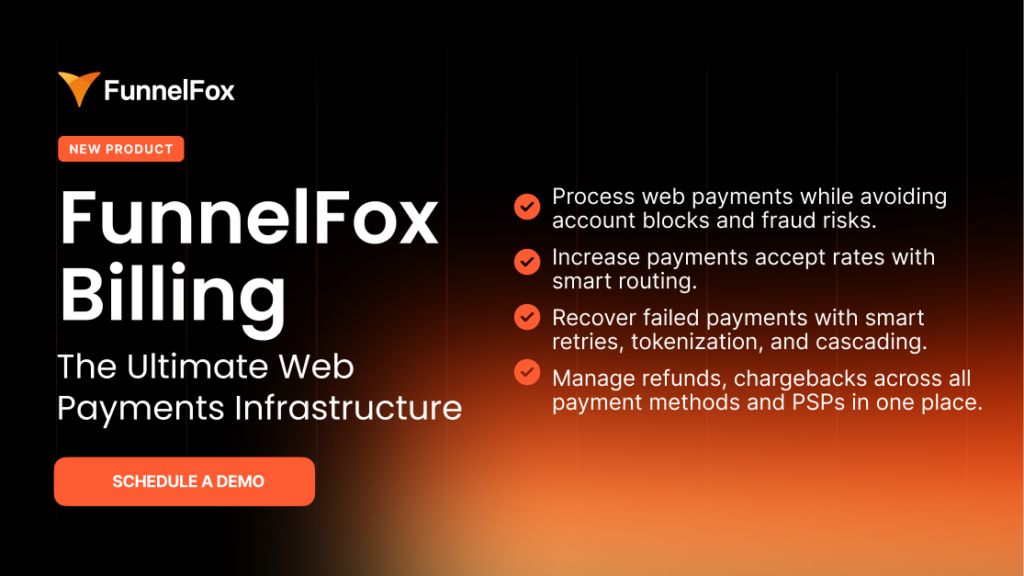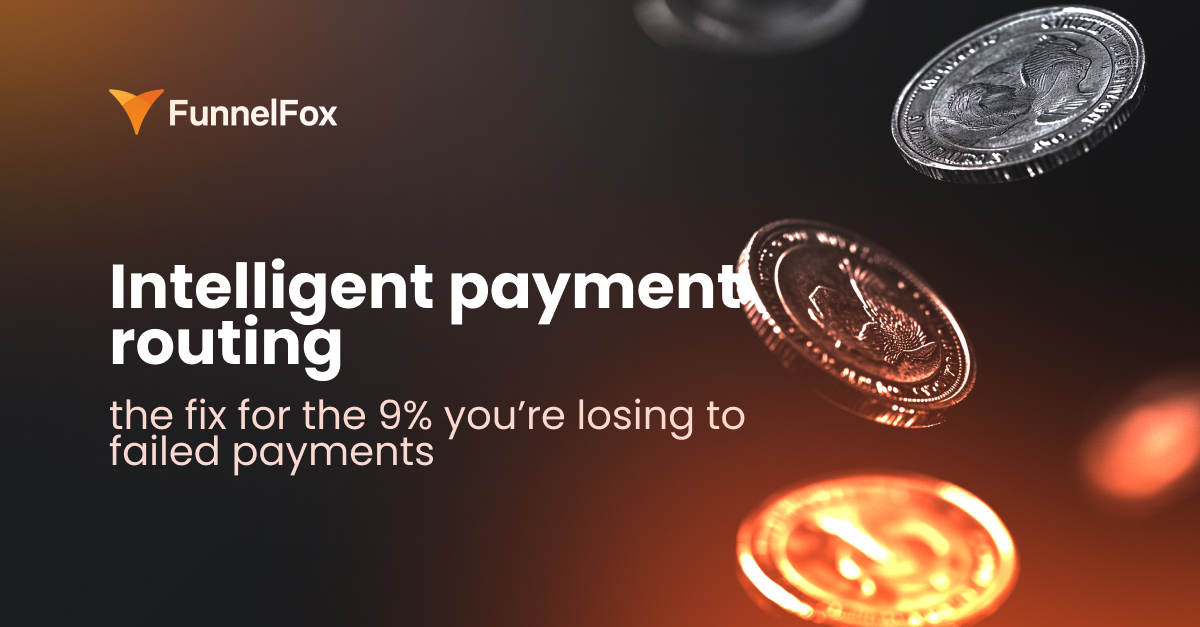Every time we talk about growing subscription revenue, the convo goes straight to acquisition funnels, onboarding UX, maybe a pricing experiment or two. All good stuff.
But growth doesn’t happen if the money never lands.
In recurring revenue models, failed payments account for up to 20% of churn. Not because users opted out, but because their payment didn’t go through. According to some estimates, this silent failure costs businesses up to 9% of annual revenue.
It’s an infrastructure problem, and dynamic, or intelligent payment routing is one of the most effective — and underused — solutions.
So, what is intelligent payment routing?
At its core, intelligent (or dynamic) payment routing is a system that selects the best available path for a transaction based on live context.
Think of it like logistics. If you’re shipping a package across the world, you don’t always choose the same carrier. You check the weather, route delays, customs bottlenecks, and then decide.
Intelligent payment routing works the same way. Only instead of roads and planes, it works with PSPs, cards, banks, geographies, and risk signals.
Dynamic vs. static payment routing
Traditional static routing sends a fixed percentage of payment traffic to each provider — for example, 70% to Provider A and 30% to Provider B — with no adjustments based on performance or context.
It’s simple, but rigid. If a provider goes down, starts failing transactions in a specific region, or flags legitimate traffic as risky, the system won’t adapt unless someone intervenes manually.
Dynamic payment routing solves this by making real-time decisions. It assesses live context — card type, geography, issuing bank, recent failures, fraud risk — and automatically selects the provider with the highest chance of success.
For example, a user in a certain country might have a higher acceptance rate with a local acquirer. Intelligent payment routing detects this and reroutes accordingly, no manual input required.
The outcome: higher authorization rates, lower failure-related churn, and more stable revenue. For teams operating across markets or outside native app stores, this kind of adaptive infrastructure is a must.
What are the benefits of optimizing payment routing?
Intelligent payment routing is more than just a backend upgrade — it has a direct, measurable impact across revenue, retention, cost, and customer experience. Here’s how the gains stack up:
1. Higher acceptance rates
The most direct win: more payments go through. Routing transactions to the right provider based on geography, card type, or bank increases the chances of a successful charge, especially in regions where PSP performance varies.
2. Fewer failures
Many failed payments are the result of technical mismatches: unsupported cards, local compliance issues, or timeouts. Intelligent routing avoids these by selecting routes built to handle the specific context.
3. Better revenue recovery
Failed payments don’t always mean lost revenue. With fallback logic and smart retries, many of these can be recovered without extra steps for the user. This reduces involuntary churn and helps retain more recurring revenue.
4. Lower chargeback risk
Routing decisions can account for historical risk signals and dispute rates. That helps avoid triggering fraud flags, lowers the chance of account freezes, and gives you more control over dispute exposure across providers.
5. Reduced processing costs
Different providers charge different fees. Intelligent payment routing can prioritize lower-cost providers when the risk and performance are equal, saving margin without compromising success rates.
6. Better user experience
The rerouting is invisible to the user. Payments feel faster and more stable, even if the system quietly switched providers behind the scenes. No errors, no interruptions — just a checkout flow that works.
How to set up global intelligent payment routing?
Global audiences come with global complexity: multiple currencies, card types, local acquirers, region-specific fraud rules, and inconsistent PSP performance. To handle this at scale, payment routing needs to adapt in real time, based on geography, issuer behavior, risk signals, and provider availability. And that requires more than just connecting a few PSPs.
A scalable routing system depends on several core components:
- Smart decision engine. The logic layer. It evaluates the context and decides in real time which PSP to use, when to retry, and how to respond to declines.
- Token vault or network tokenization. To keep billing seamless across providers, you need token-level control. A vault holds reusable, PSP-agnostic tokens or uses scheme-level tokenization to allow cross-provider retries without user input or re-authentication.
- Multi-PSP integration. Provides routing flexibility and redundancy. Allows traffic to be distributed by region, cost, or success rate, and protects against provider-specific downtime.
- Real-time routing rules. Dynamically adjusts to changing conditions — retry timing, fallback priorities, issuer-specific behavior, fraud signals, and compliance constraints.
Payment routing can be built in-house, handled through payment orchestration platforms like Primer or Solidgate, or implemented as lightweight logic across multiple PSPs — depending on the team’s scale, resources, and need for control.
The simplest way? Use FunnelFox Billing
It brings together all the essential components of intelligent routing — smart decision engine, token-level control, multi-PSP integration, and real-time rules — in a single, unified platform. With FunnelFox Billing, you get global payment optimization out of the box, so you can start recovering more revenue and reducing payment failures instantly, without heavy custom engineering.

How to optimize payment routing for efficiency?
Even with a smart architecture in place, routing efficiency doesn’t happen by default. The system must be continuously monitored, tested, and adjusted based on live data and performance signals. Optimization becomes a loop.
Step 1: Spot the weak links
Look at payment failure rates by PSP, geography, card type, and issuer; unusually low conversion from trial to paid; or drop-offs during renewal cycles. These often signal poor provider performance or rigid routing logic.
Step 2: Test alternative routes
Run A/B tests across providers, especially in high-volume or high-risk markets. For example, in Brazil, Adyen might outperform Braintree on LTV despite similar base fees, simply because of better acceptance rates and local acquiring. Track downstream impact on LTV and retries.
Step 3: Deploy smart fallback logic
Introduce context-aware retry flows. Switch providers based on decline codes, avoid redundant retries with the same PSP, and prioritize historically successful routes.
Step 4: Measure performance
Go beyond approval rates. Monitor:
- Recovery rates after retry
- Time-to-authorize
- Cost per successful payment
- Revenue per route per region
Evaluating changes over time — by geography, channel, and provider — helps isolate what drives improvement. In payment routing, even minor gains in efficiency can compound into meaningful revenue growth at scale.
Wrap up
In subscription-based products, what happens at the point of charge — and what happens when it fails — has more impact on revenue than many teams expect. This is especially true for mobile apps that charge on the web, outside of native app stores, and manage their own payment infrastructure. In these setups, there’s no safety net: routing decisions directly affect conversion, retention, and revenue.
Even a basic intelligent payment routing layer can recover up to 30% of failed transactions — a simple, high-impact way to grow subscription revenue with minimal effort.








